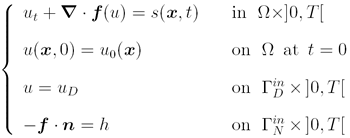|
|
Equations governing transient convection problem are
 |
|
Note that boundary conditions are only imposed on the inflow boundary.
|
|
|
|
We will now only consider linear problems, so that the convective
term can be written as
f(u) = a u
with a
independent of the solution u.
When the convection velocity a
is divergence-free the problem can be rewritten as
The main feature of this equation is that space and time are linked by the characteristics.
To compute a numerical solution, a double discretization has to be performed
(in space and in time) and to obtain accurate solutions it cannot be done anyhow.
Stability of numerical methods depends on the Courant number
 ,
that links spatial and time discretization. ,
that links spatial and time discretization.
It is also important the order in which discretizations are performed. We will first carry out
time discretization using one of the following time-stepping algorithms:
 |
 - family methods (such as Euler, Crank-Nicolson...) - family methods (such as Euler, Crank-Nicolson...) |
 |
Lax-Wendroff method |
 |
Leap-Frog method |
 |
Taylor-Galerkin methods (higher order) |
Then, we use the finite element method for solving the steady problem
posed in each time step.
|
|